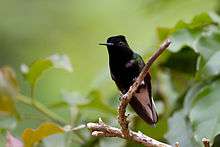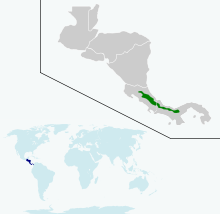Black-bellied hummingbird
The black-bellied hummingbird (Eupherusa nigriventris) is a species of hummingbird in the family Trochilidae.
| Black-bellied hummingbird | |
|---|---|
 | |
| Scientific classification | |
| Kingdom: | Animalia |
| Phylum: | Chordata |
| Class: | Aves |
| Order: | Apodiformes |
| Family: | Trochilidae |
| Genus: | Eupherusa |
| Species: | E. nigriventris |
| Binomial name | |
| Eupherusa nigriventris Lawrence, 1867 | |
 | |
It is found in moist forest and edge at middle elevations on the Caribbean slope in the Talamancan montane forests. When breeding they'll reach elevations between 900-2000m, and then afterwards many descend to 600m.[2][3]
Per the name, the species has a black underbelly in males, but in females sexual dimorphism is displayed through a light grey underbelly.[2] Males also tend to molt 1-2 months before the female.[4]
Behavior
Hummingbirds will often claim specific flowers and guard them. This species is no different where the dominant males will lay claim to flowers in the canopy of a forest.[2] Females will focus more on understories or forest edges where there is less competition.[2] Its call has been identified as a sharp 'tseep' or peet', with sharp tsittering' during chases, and a 'high thin sputtering warble' for its song.[2]
Breeding and diet
Its diet consists of arthropods and the nectar of Inga and Pithecellobium, epiphytes (Ericaceae, Columnea, Eleanthus, Norantea), and flowers of Cephaelis, Witheringia, and Besleria (Stiles and Skutch 1989).[2] In certain studies it has demonstrated greater interest towards short flower types vs long.[5] The abundance of its flowers has correlated with when this species breeds - usually from October to March.[2][4] With a nest only 2-4m off the ground, the clutch normally has ~2 plain white eggs.[2]
References
- BirdLife International (2012). "Eupherusa nigriventris". IUCN Red List of Threatened Species. 2012. Retrieved 26 November 2013.CS1 maint: ref=harv (link)
- "Black-bellied Hummingbird". neotropical.birds.cornell.edu. Retrieved 26 May 2019.
- "Black-bellied Hummingbird (Eupherusa nigriventris)". www.hbw.com. Retrieved 26 May 2019.
- Stiles, F. Gary (January 1985). "Seasonal Patterns and Coevolution in the Hummingbird-Flower Community of a Costa Rican Subtropical Forest". Ornithological Monographs (36): 757–787. doi:10.2307/40168315. JSTOR 40168315.
- Maglianesi, María A.; Böhning-Gaese, Katrin; Schleuning, Matthias (May 2015). Ings, Thomas (ed.). "Different foraging preferences of hummingbirds on artificial and natural flowers reveal mechanisms structuring plant-pollinator interactions". Journal of Animal Ecology. 84 (3): 655–664. doi:10.1111/1365-2656.12319. PMID 25400277.
